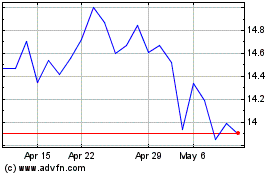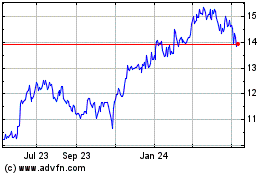Danish Bank Knew of Russia Clients -- WSJ
September 19 2018 - 3:02AM
Dow Jones News
By Patricia Kowsmann, Drew Hinshaw and Bradley Hope
This article is being republished as part of our daily
reproduction of WSJ.com articles that also appeared in the U.S.
print edition of The Wall Street Journal (September 19, 2018).
Bank officials at the center of one of Europe's largest money
laundering scandals knew earlier than previously indicated about
problems at its tiny Estonian branch, including that it held
accounts for blacklisted Russian clients, according to
correspondence seen by The Wall Street Journal and Estonia's
financial regulator.
It is the latest indication that officials at Danske Bank were
aware almost two years before it started shutting questionable
accounts that the small but highly profitable branch was involved
in potentially illicit money flows.
Danske Bank, Denmark's biggest bank, is being probed by U.S.
authorities who want to know why its tiny branch in the former
Soviet republic of Estonia processed as much as $150 billion in
transactions from 2007 to 2015 from foreign countries, mainly
Russia. Denmark's politicians -- and a falling share price -- have
put pressure on the bank to disclose how much its executives knew
about any suspicious money shifting through there. The bank is
scheduled to disclose findings from an internal probe on
Wednesday.
A Danske spokesman declined to comment.
In an April 2013 email, Danske Bank's anti-money-laundering
chief, based in Denmark, asked colleagues in the Estonia branch
about client accounts whose owners appeared on a blacklist
generated by Russia's central bank. Russia's central bank keeps a
database of individuals and companies suspected of financial
wrongdoing -- about 500,000 presently -- and shares it across
borders.
Estonian authorities had repeatedly complained to Denmark's
banking supervisor, the email said: "They have the impression that
we do not take the issue very seriously," wrote Niels Thor
Mikkelsen, the bank's then-compliance executive.
The Danish Financial Supervisory Authority -- in charge of
making sure Denmark's banks obey anti-money-laundering rules -- was
"very worried because they have confirmed to U.S. authorities that
we comply with Danish [anti-money-laundering] requirements," he
wrote, copying the email to several employees of the branch. "The
Danish FSA has helped the Bank in a critical situation. They are
now very worried that any situation may arise."
It wasn't clear, Mr. Mikkelsen wrote, if Danske Bank's Estonia
branch was indeed in compliance. He asked a series of questions
about the blacklisted clients, such as "How do we handle their
relationship?"
Mr. Mikkelsen declined to comment, citing legal secrecy. In an
email Tuesday, Estonia's Financial Supervision Authority confirmed
it repeatedly complained to Danish counterparts about the branch's
blacklisted customers.
A spokesman for the Danish FSA referred to a paragraph in a
reprimand ruling it issued against Danske in May, which says it
received "misleading" information from the bank between 2012 and
2014. Danske says the information it received came from the
branch.
The Russian Central Bank didn't immediately respond to requests
for comment.
The email about the Russian blacklist indicates Danske Bank
officials were aware of problems in the first half of 2013.
According to a statement it published in July, Danske Bank said it
got word of serious problems at its Estonia branch when a
whistleblower tipped them off in December 2013.
Banking blacklisted clients could put Danske afoul of regulators
in Russia, where the Danish bank has a subsidiary.
"The Russian Central Bank is by Russian standards relatively
reputable," said Mark Galeotti, an expert on Russian financial
crime at Prague's Institute of International Relations. "You take
the names that are on that list seriously."
Danske is Denmark's largest bank, holding over a third of the
country's customer deposits. It expanded in recent decades across
Northern Europe and the Baltics.
The Estonia branch was one of its profit drivers, making EUR63
million ($73.5 million) in 2012 in net profits, the branch's most
lucrative year, according to the bank supervisor's records. That
year, the entire bank, still wrestling with the aftermath of the
2008 financial crisis, reported EUR636.6 million in net
profits.
Write to Patricia Kowsmann at patricia.kowsmann@wsj.com, Drew
Hinshaw at drew.hinshaw@wsj.com and Bradley Hope at
bradley.hope@wsj.com
(END) Dow Jones Newswires
September 19, 2018 02:47 ET (06:47 GMT)
Copyright (c) 2018 Dow Jones & Company, Inc.
Danske Bank AVS (PK) (USOTC:DNKEY)
Historical Stock Chart
From Mar 2024 to Apr 2024

Danske Bank AVS (PK) (USOTC:DNKEY)
Historical Stock Chart
From Apr 2023 to Apr 2024
